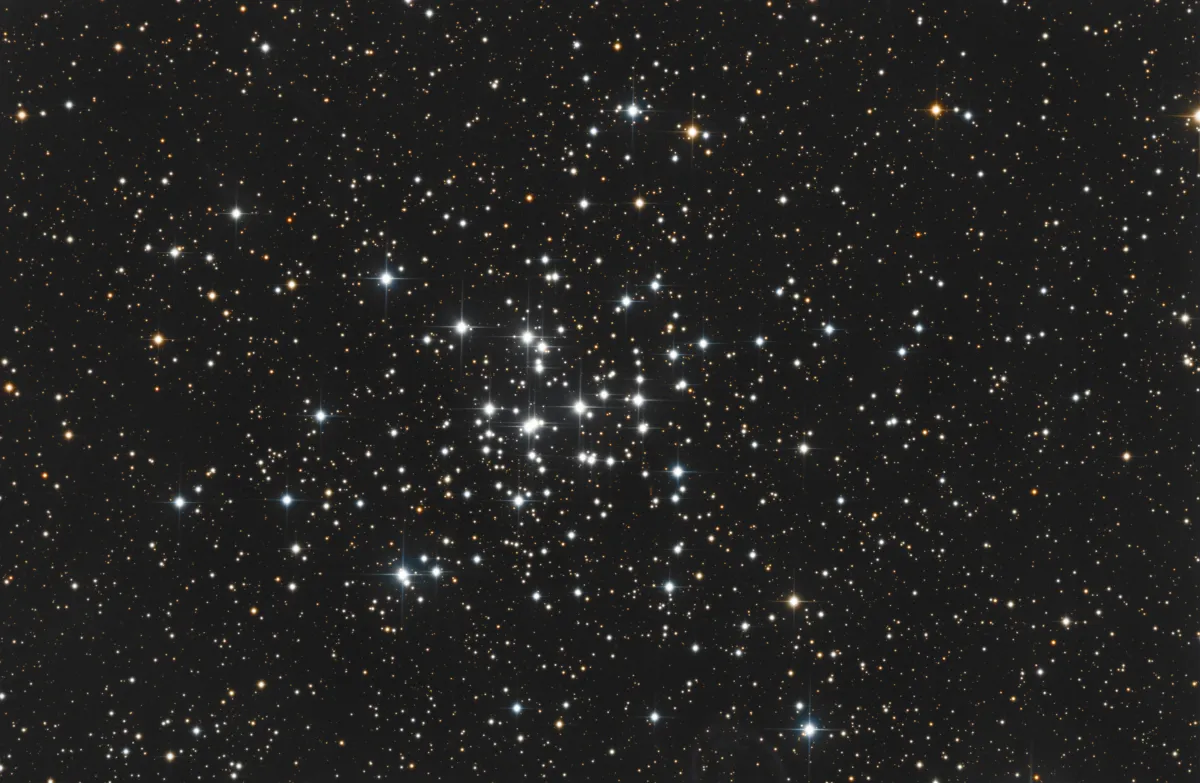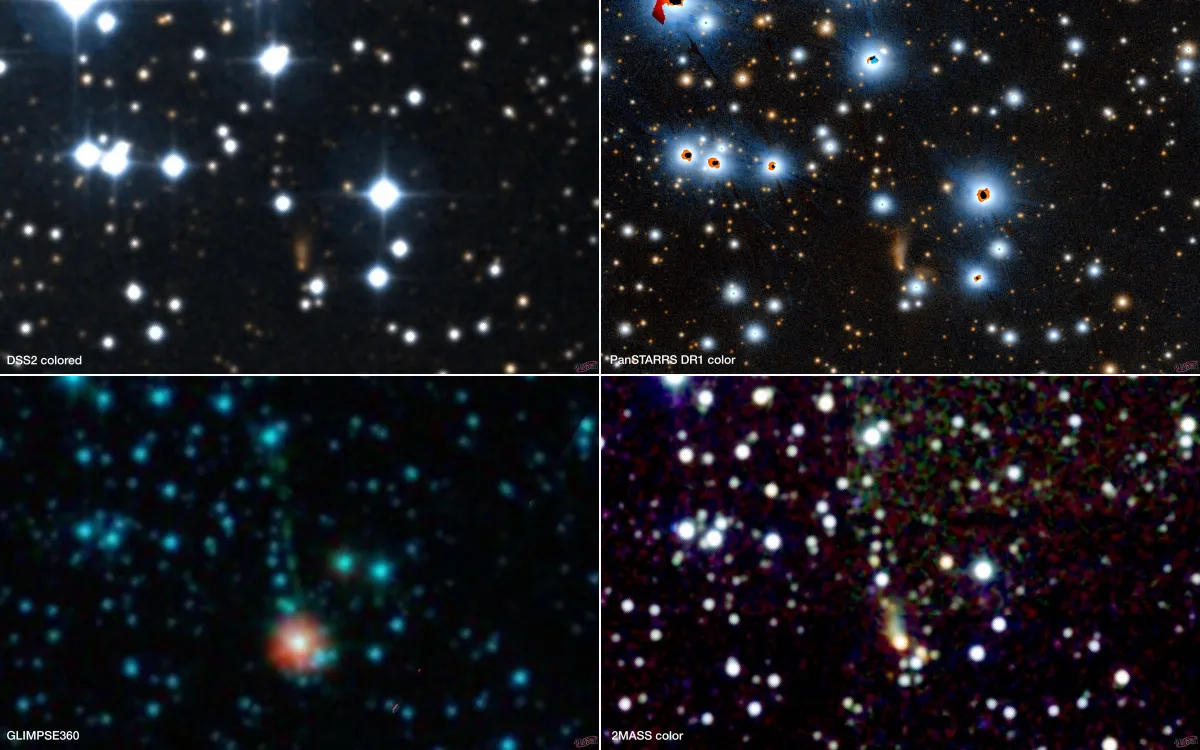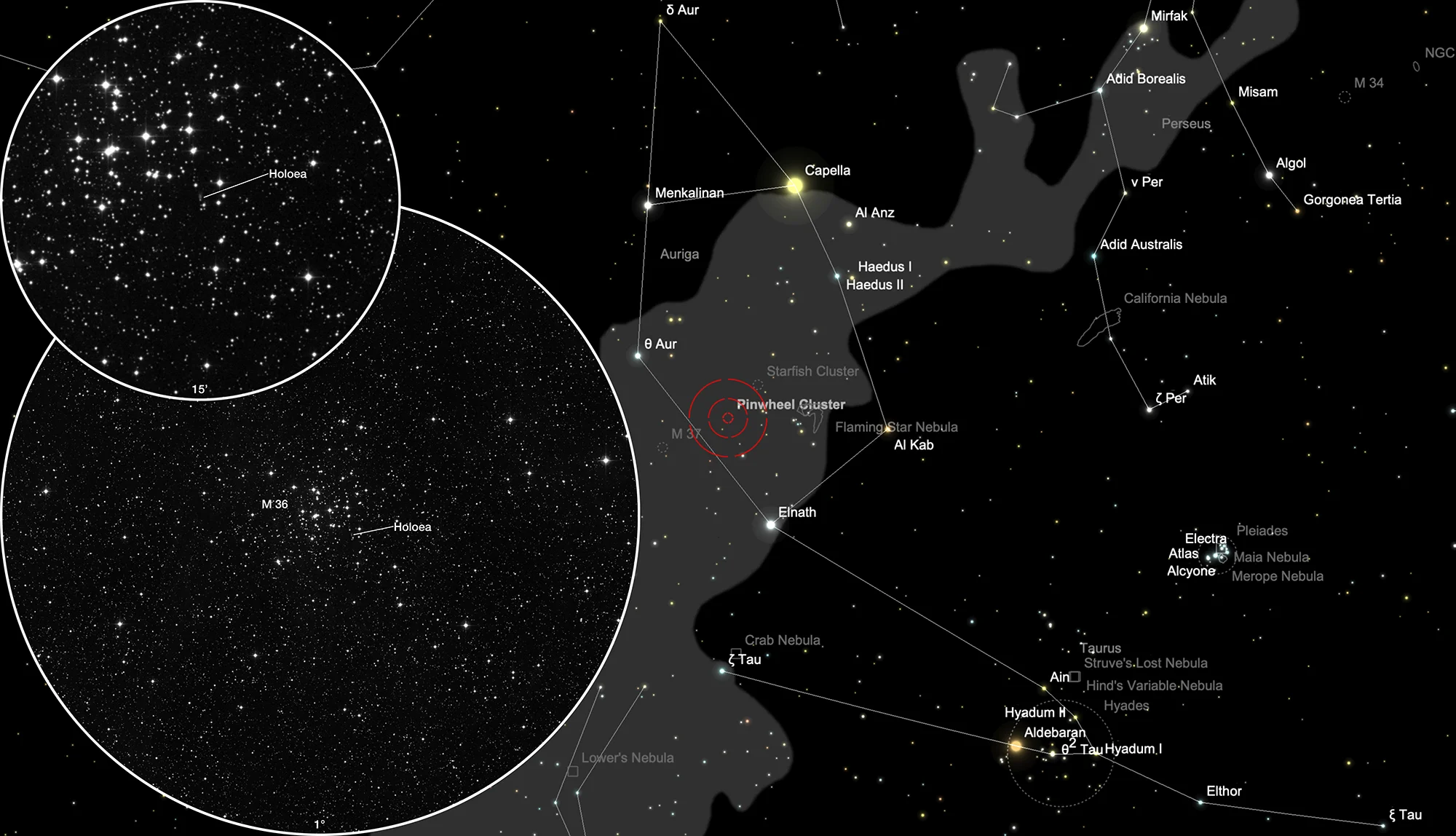Pinwheel Cluster Messier 36 & Holoea (IRAS 05327+3404)

Messier 36
M 36 is the first of the three bright Messier star clusters in the constellation Auriga. The other two are M 37 and M 38. It was discovered in 1654 by Giovanni Hodierna and then again in 1749 by Guillaume Le Gentil. [4] Charles Messier noted on 2 September 1764: «Cluster of stars in Auriga, near the star φ: with an ordinary telescope of 3 and a half feet, it is difficult to distinguish the stars, the cluster shows no nebulosity. Its position is determined by φ.» [281]
The star cluster is of the Trumpler type II3m and contains about 60 stars from 9th to 14th magnitude. The centre with the brightest stars measures about 10 arc minutes in diameter and contains the binary star Struve 737 (Σ 737, ADS 4194, distance 10.7"). M 36 is one of the younger star clusters with bright B-type stars and no red giants. Measured distances range from 1200 up to 1318 pc. [4, 145]
| Designation | NGC 1960 |
| Type | OCL (II3m) |
| Right Ascension (J2000.0) | 05h 36m 17.7s |
| Declination (J2000.0) | +34° 08' 27" |
| Diameter | 10 arcmin |
| Visual magnitude | 6.0 mag |
| Metric Distance | 1.318 kpc |
| Dreyer Description | Cl, B, vL, vRi, lC, st 9…11 sc |
| Identification, Remarks | h 358; GC 1166; M 36; OCL 445 |

Holoea (IRAS 05327+3404)
This object was first detected using IRAS (Infrared Astronomical Satellite). Launched on 25 January 1983 for a ten month mission, IRAS was the first space observatory to perform an all-sky survey at infrared wavelengths. Based on the IRAS data Wouterloot and Brand used in May/June 1988 the 30m IRAM radio telecope at Pico Veleta in Spain for a CO emission survey, searching for star forming regions along the of the galactic plane. The object is there referred as WB89 663. [646]
In 1995 Magnier et al. used the Michigan-Dartmouth-MIT (MDM) Observatory at Kitt Peak and have discovered an object in the field of M 36 which exhibits a nebulous tail-like structure and a high velocity outflow. The position showed to to be coincident with the infrared source IRAS 05327+3404. Further studies conducted that this is a young stellar object (YSO), surrounded by large amounts of circumstellar material. The central star is directly visible and of spectral type K2. It is a T Tauri star in transition from a protostar (class I) to a pre-main-sequence star (class II). The star is probably not associated with the open cluster M 36 and may be a far-flung member of the star forming region Sh 2-235 circa 2° to the north east of it. The outflow was nicknamed «Holoea» («holo ea» meaning «flowing gas» in Hawaiian) because of the unusually powerful ionized outflow. [647, 648]
| Name | IRAS 05327+3404 |
| Object Type | Young Stellar Object |
| Right Ascension (J2000.0) | 05h 36m 06s |
| Declination (J2000.0) | +34° 06' 12" |
| Parallaxes | 1.8769 mas |
| Spectral type | K2IIIe |
| Magnitudes | V 18.62; G 19.307945; J 13.4; H 11.975; K 10.487 |
| Identifiers | 2MASS J05360598+3406120; Gaia DR2 3449518037644343040; Gaia DR3 3449518037644343040; IRAS 05327+3404; NAME Holoea; TIC 115559958; WB89 663; WISE J053605.96+340612.0; [AR2002] IRAS 05327+3404 VLA 2; [MKH2013] SMM1 |
Thanks to Casper le Fantôme for the object hint.
Finder Chart
The open star cluster is located within the pentagon in the constellation Auriga and is visible to the naked eye on a dark night. The best observation time is August to May.
Visual Observation
400 mm Aperture: In the 21 mm Ethos eyepiece M 36 appears as a loose open cluster, consisting of white stars only. It is conspicuous but not very impressive. After some orientation the exact position of Holoea in the little circlet of small stars could be determined, however remained hidden even with averted vision and some patience, even when switching to higher magnification. Holoea is too dim. — 400 mm f/4.5 Taurus Dobsonian, Hasliberg, SQM 21.0, 3. 2. 2024, Bernd Nies
